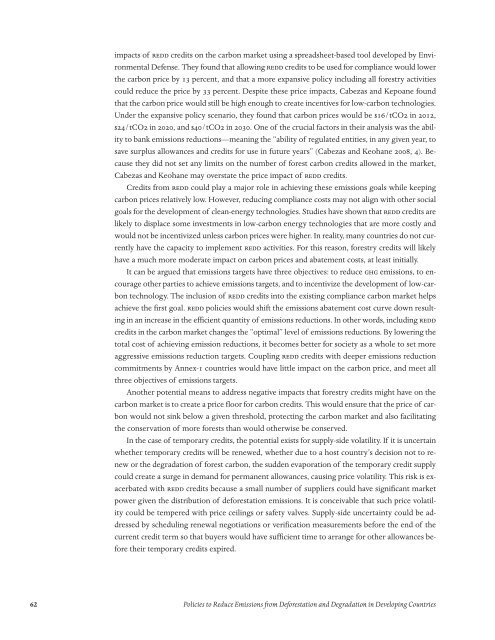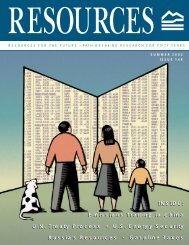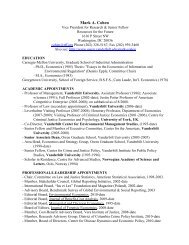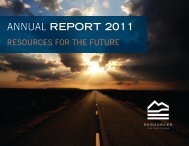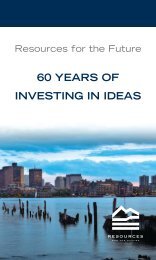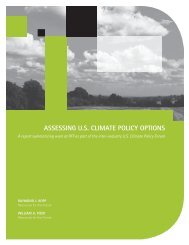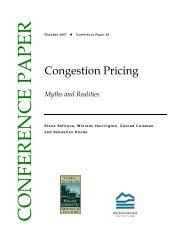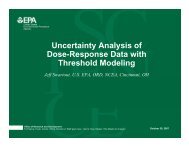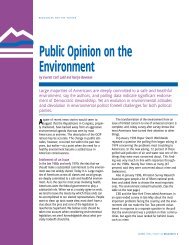Policies to Reduce Emissions from Deforestation and Degradation ...
Policies to Reduce Emissions from Deforestation and Degradation ...
Policies to Reduce Emissions from Deforestation and Degradation ...
Create successful ePaper yourself
Turn your PDF publications into a flip-book with our unique Google optimized e-Paper software.
impacts of REDD credits on the carbon market using a spreadsheet-based <strong>to</strong>ol developed by Environmental<br />
Defense. They found that allowing REDD credits <strong>to</strong> be used for compliance would lower<br />
the carbon price by 13 percent, <strong>and</strong> that a more expansive policy including all forestry activities<br />
could reduce the price by 33 percent. Despite these price impacts, Cabezas <strong>and</strong> Kepoane found<br />
that the carbon price would still be high enough <strong>to</strong> create incentives for low-carbon technologies.<br />
Under the expansive policy scenario, they found that carbon prices would be $16/tCO2 in 2012,<br />
$24/tCO2 in 2020, <strong>and</strong> $40/tCO2 in 2030. One of the crucial fac<strong>to</strong>rs in their analysis was the ability<br />
<strong>to</strong> bank emissions reductions—meaning the “ability of regulated entities, in any given year, <strong>to</strong><br />
save surplus allowances <strong>and</strong> credits for use in future years” (Cabezas <strong>and</strong> Keohane 2008, 4). Because<br />
they did not set any limits on the number of forest carbon credits allowed in the market,<br />
Cabezas <strong>and</strong> Keohane may overstate the price impact of REDD credits.<br />
Credits <strong>from</strong> REDD could play a major role in achieving these emissions goals while keeping<br />
carbon prices relatively low. However, reducing compliance costs may not align with other social<br />
goals for the development of clean-energy technologies. Studies have shown that REDD credits are<br />
likely <strong>to</strong> displace some investments in low-carbon energy technologies that are more costly <strong>and</strong><br />
would not be incentivized unless carbon prices were higher. In reality, many countries do not currently<br />
have the capacity <strong>to</strong> implement REDD activities. For this reason, forestry credits will likely<br />
have a much more moderate impact on carbon prices <strong>and</strong> abatement costs, at least initially.<br />
It can be argued that emissions targets have three objectives: <strong>to</strong> reduce GHG emissions, <strong>to</strong> encourage<br />
other parties <strong>to</strong> achieve emissions targets, <strong>and</strong> <strong>to</strong> incentivize the development of low-carbon<br />
technology. The inclusion of REDD credits in<strong>to</strong> the existing compliance carbon market helps<br />
achieve the first goal. REDD policies would shift the emissions abatement cost curve down resulting<br />
in an increase in the efficient quantity of emissions reductions. In other words, including REDD<br />
credits in the carbon market changes the “optimal” level of emissions reductions. By lowering the<br />
<strong>to</strong>tal cost of achieving emission reductions, it becomes better for society as a whole <strong>to</strong> set more<br />
aggressive emissions reduction targets. Coupling REDD credits with deeper emissions reduction<br />
commitments by Annex-1 countries would have little impact on the carbon price, <strong>and</strong> meet all<br />
three objectives of emissions targets.<br />
Another potential means <strong>to</strong> address negative impacts that forestry credits might have on the<br />
carbon market is <strong>to</strong> create a price floor for carbon credits. This would ensure that the price of carbon<br />
would not sink below a given threshold, protecting the carbon market <strong>and</strong> also facilitating<br />
the conservation of more forests than would otherwise be conserved.<br />
In the case of temporary credits, the potential exists for supply-side volatility. If it is uncertain<br />
whether temporary credits will be renewed, whether due <strong>to</strong> a host country’s decision not <strong>to</strong> renew<br />
or the degradation of forest carbon, the sudden evaporation of the temporary credit supply<br />
could create a surge in dem<strong>and</strong> for permanent allowances, causing price volatility. This risk is exacerbated<br />
with REDD credits because a small number of suppliers could have significant market<br />
power given the distribution of deforestation emissions. It is conceivable that such price volatility<br />
could be tempered with price ceilings or safety valves. Supply-side uncertainty could be addressed<br />
by scheduling renewal negotiations or verification measurements before the end of the<br />
current credit term so that buyers would have sufficient time <strong>to</strong> arrange for other allowances before<br />
their temporary credits expired.<br />
2 <strong>Policies</strong> <strong>to</strong> <strong>Reduce</strong> <strong>Emissions</strong> <strong>from</strong> <strong>Deforestation</strong> <strong>and</strong> <strong>Degradation</strong> in Developing Countries


